JOHN S HASLAM
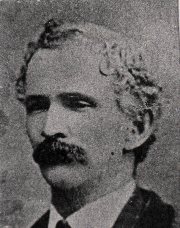
His Birth
John Haslam was born May 21, 1823 in Little Leaver, near Bolton, Lancashire, England. The circumstances of his birth are a family mystery. John’s mother was Elizabeth (or Betsy) Haslam. She was a lady worker and teacher at the Duke of Bridgewater’s estate at Worsley. During this time she gave birth to an illegitimate son, John. The name of John’s father was kept confidential during John’s lifetime. In 1958, John’s daughter, Anne Isabel Haslam Luce, admitted that her father was the illegitimate son of Prince William, later King William IV of England. Prince William was a frequent visitor at the Duke of Bridgewater’s estate.
The following represents family comment and research on this subject:
“In
1958, Annie Isabel Haslam Luce admitted that her father John
S Haslam was the illegitimate son of Prince William, later
King William IV of England. This had been kept strictly
confidential in the family over the years. His Mother,
Elizabeth (Betsy) Haslam was a lady worker and teacher at
the Duke of Bridgewater's Manor House Estate at Worsley. The
Duke of Bridgewater enjoyed an excellent relationship with
the Royal Family at Windsor Castle near London, and was held
in high regard because of his engineering skill in canal and
bridge construction. He and Prince William visited each
other on many occasions. It was not uncommon for them to
include their servants and staff on these occasions. It is
reasonably certain that Betsy Haslam accompanied the
Bridgewater party on their visits to Windsor Castle. During
this time she bore an illegitimate son on May 31, 1823 who
she named John. This event, according to our researcher,
Edith Norris of Bolton, England was greatly talked about by
the people in Bolton, and they were convinced that Prince
William had fathered the child. Mrs. Norris remembered this
being discussed in her family when she was young. Although
no acknowledgment was made of an open financial settlement,
our researcher, Jennie Weeks of Salt Lake City, Utah said
that Prince William sent a bag of money periodically to
support the child, according to three sources of information
she had received from England. John was seven years old when
Prince William became King William IV.” (Gladys
Haslam Drennan)
“It was during times like
these, and perhaps they were a contributing factor, that
caused Elizabeth (Betsy) Haslam to go into service at the
estate of the Duke of Bridgewater located at Worsley near
Bolton. It was not uncommon for the mistress of the estate
to select girls from the staff to work and reside in the
main house. Betsy was one of those girls. The Duke of
Bridgewater enjoyed an excellent relationship with the Royal
family at Windsor Castle near London and was held in high
regard because of his engineering skill in canal and bridge
construction. The Duke of Bridgewater visited Windsor Castle
on many occasions and likewise Prince William was the guest
of the Duke and it was not uncommon for royalty to include
their servants and staff on these occasions. It is
reasonable certain that Betsy accompanied the Bridgewater
party during their visits to Windsor Castle. During the
period of service she bore an illegitimate son, whom she
named John. This event was greatly talked about by the
people of Bolton and they were convinced Prince William had
fathered the child. Whether this allegation was justified or
not there was ample evidence that several years before
Prince William had sired a number of illegitimate children
by an actress with whom he lived openly for many years.
There was no attempt to keep these events a secret, and on
his eldest illegitimate son he openly conferred the title of
the Duke of Clarence. Settlements were also made upon his
other illegitimate children and their welfare was openly
acknowledged. John S. Haslam was born March 3, 1823, but no
acknowledgment of an open settlement was ever forthcoming
from the prince because of this marriage. However, I believe
Elizabeth (Betsy) Haslam died and John Haslam was adopted
and reared by the Hardmans. Jane Haslam Hardman was Betsy's
sister. This would lend support to the fact that there
seemed to be substance and means behind the Hardman family.
The local people assumed this support came from the Royal
family since the Hardmans appeared to prosper even during
economically depressed times. There is no doubt in my mind
but that this John Haslam and your grandfather are one and
the same person. For the story that I have heard all my life
and the facts that you have told me are more than a mere
coincidence.” (Velda Haslam Johnson)
“We
know that grandfather John S. Haslam was the illegitimate son
of Betsy (Elizabeth) Haslam and that he said his father’s name
was William and that much work over the years has gone into
genealogical research...Also in a letter we found in Katie and
Jennie Week’s correspondence from Mrs. Norris she states that
the Hardmans and Betsy Haslam lived on the Duke of Bridgewater
Estate and the Duke also had a brother who name was William.
Their name was Egerton...We have talked to Bob Gunderman in
the Medieval and Royalty department in the Joseph Smith
Memorial Building Library in Salt Lake. We gave him the
information we have concerning the William grandfather gave as
his father, and also gave his the information that Mrs. Norris
had given us. Mr. Gunderman informed us that there is no way
possible that we can prove this, although it could very well
be true. He also stated that it is very important that we have
John S. Haslam and his mother Betsy sealed to her father,
because that is the blood line.” (Velda Haslam Johnson)
“This is the history of my
grandfather, John S. Haslem as I have been told it by my
older relatives, that I have reason to believe should know
and would have no reason to tell me anything but the truth
as they knew it. First, I will start with my Aunt Lizzie
Bennett, who was his daughter. She said her father ran away
from home in England at twelve years old and got a job on a
ship. This story Aunt Lizzie told me doesn't go along with
the story we got from Mrs. Morris, our genealogist in
England. She says John S. Haslem served as an English
sailor, and Aunt Lizzie says he told her he was a runaway
after twelve years old. Mrs. Morris says the King endowed
all of his illegitimate children except John S., and it is
my thought that the reason was because the King didn't know
where he was. I have read a letter from the caretaker of
those children that said, "We have finally found John S.
Haslem. He is in America and has joined the Brighamites." I
know my Aunt Lizzie Bennett wouldn't tell me the story her
father told her wrong, so just take your choice which story
you think is correct.” (John H. Haslem)
No
christening record or other primary documentary proof has been
found to establish the exact facts of John’s birth. The record
of John Haslam as a Seventy in Nauvoo shows his father as
William, with no last name given.
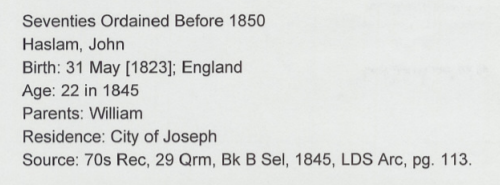
Nauvoo Seventies Quorum record for John Haslam
The
anecdotal evidence supplied by his daughter is compelling, but
not conclusive. In the absence of any documentary evidence,
the solution to this question may lie in molecular genealogy.
If a know direct male descendant of King William IV (such as
the Fitzclarences), and a direct male descendant of John
Haslam were tested and had matching DNA, the connection would
be proved.
His Childhood
At
the time of John’s birth, Bolton
was a town that had been impacted greatly by the Industrial
Revolution. A description of Bolton in 1814-15 in the
Commercial Directory states, “Bolton-le-Moors is an
ancient manufacturing town of considerable consequence in
Lancashire, eleven miles from Manchester. It has been
considered as the original seat of the cotton trade in this
county, and for the manufacture of ornamental and fancy
goods is still particularly celebrated. Bolton enjoys a
healthy situation, and abounds with springs of the finest
water, some of which have been highly celebrated for their
medicinal virtues. Bolton is surrounded by mines of
excellent coal, and enjoys the advantage of a communication
by canal with Manchester and Bury. The population, which in
the year 1773, amounted to but 5,339 persons, is now
increased to 24,149.” Bolton is set on the edge of a
vast area of Pennine moorland.
Betsy
Haslam
died when John was only nine years old, and that he was raised
by Betsy’s sister, Jane. Betsy was only 32 years old when she
died on 6 May 1832. There is no record of a marriage or other
children for her. Betsy's sister, Jane also had an
illegitimate son, Thomas in 1815, when she was 21 years old.

Baptism record for Thomas Haslam in Bolton le Moors (Bishops Transcripts)
"18th Thomas s. of Jane Haslam, Haulgh, Spinster, Thos Brocklebank curate"
Jane married John Hardman on 13 May 1832, just seven days
after Betsy’s death. Jane and John Hardman had six children:
Elizabeth, James, Rodger, Sarah and Giles, who were twins, and
Martha. John Haslam considered the Hardman children as his
brothers and sisters. John stayed close to the Hardman
children and to Jane’s son, Thomas Haslam. Several letters to
and from these siblings are in family possession. (Click here to see letters to
John Haslam from his family.) Gladys Haslam Drennan
recounts “According to my grandmother, Mary Ann Kay Haslam
(the second wife of John S Haslam), John had to work in the
coal mine as a child, where there was no equipment or
machinery to do the work. John had to carry coal in baskets
on top of his head which caused him to have a thick neck.
Later at the age of fourteen his mother (this must be
his adopted mother Jane) bound him over to a Mr.
Wordley to learn the blacksmith trade. He did not receive
any wages, just his room and board. He was near Bolton. It
is thought that his mother died, and John was adopted or
reared by the Hardmans. Jane Hardman was Betsy's sister.
This would tend to support the fact that there seemed to be
substance and means behind the Hardman family. Local people
assumed this support came from the Royal Family since the
Hardmans appeared to prosper even during economically
depressed times. When John was sixteen years of age, he
served in the British Navy for a while, later leaving for
America, never to go back to England. However, his
relatives, the Hardmans, corresponded with him.” If John
was the son of William IV, then financial support may have
stopped in 1837, when William died. Jane Haslam died just six
years later, on 28 February 1838, of asthma. John left home to
join the Navy one year after Jane died.
His Conversion
John
S Haslam was described as “a tall handsome man with dark
tightly-curled hair and brown eyes.” In 1842, when John
S Haslam was 19, he was converted to the Church of Jesus
Christ of Latter Day Saints by Orson Hyde. While some family
histories state that John was converted on board the ship
carrying Orson Hyde home, John was baptized before the ship
left port. Acording to records on file in the Land and Records
Office in Nauvoo, John was baptized on 15 September 1842. This
was just ten days before the ship Medford left Liverpool with
214 Latter-Day Saints, including Orson Hyde. John's cousin,
Job Openshaw, was also baptized. A biography from Job's son
gives more information about John's conversion: "In
John
Haslam’s grandson says, “After making several voyages
between England and the U.S., he met this ship load of
mostly Mormon converts with the Hamers, Openshaws, and
others. He became very good friends with them, so he left
the ship and joined them at New Orleans. They all stayed
together, 35 or 40 of them.” (John Henry
Haslem) A biography of Orson Hyde states, “Orson
arrived in England sometime in August, staying about one
month. On September 25, 1842, he sailed from Liverpool on
the Medford with a group of British Saints
immigrating to Zion. They arrived at New Orleans on November
13, and went on up the Mississippi on a steamer, the Alex
Scott. At Alton, Missouri, about twenty miles north
of St. Louis, the river was too frozen for the ship to
continue. The other passengers apparently stayed with the
ship until it could continue, but Orson was so eager to get
home that he continued to Nauvoo by land.” A family history
states, “Elder Hyde was returning from his mission where he
dedicated Jerusalem for the return of the Jews. While on the
ship crossing the ocean, John heard some men plotting to
take the life of Orson Hyde upon landing. He went to Orson
Hyde and told him what he had heard, telling him to get away
as soon as possible. The Captain of the boat let Orson Hyde
disembark ahead, holding the other passengers and crew until
he was safely ahead. Thus his life was saved by this timely
warning.” (Gladys Haslam Drennan)
Nauvoo
John
stayed in St. Louis, Missouri for two years. In his obituary,
it states “He tarried in St. Louis until the summer of 1844,
and then went to Nauvoo.”
There
is a family story, mentioned in Gladys Haslam Drennan’s
biography, which states, “It was said by family members that
John S Haslam was one of six men who buried the prophet
secretly in the soil of the Nauvoo House after Joseph Smith
was assassinated, so that his enemies could not find and
desecrate his body.” Joseph Smith was martyred in June of
1844. It is impossible to substantiate that John participated
in the burial, but perhaps his association with Orson Hyde
made this possible.
John is found paying taxes in Nauvoo in 1842:
John Hasham, page 226, coordinates 6N8W
Samuel Hamer, John's future father-in-law, is found in the same list:
Samuel Hamary, page 226, coordinates 6N8W
Source: Nauvoo, Illinois Tax Index, 1842, on ancestry.com.
John met the Samuel Hamer family. They were very kind to him, and he grew to love them. Samuel Hamer was a blacksmith, and John came to work for him. Samuel died of malaria in August 1843 in Nauvoo. John became very close to the Hamer family, and married Samuel’s daughter, Martha. They were married by Orson Hyde in St. Louis on March 4, 1845. The witness was Samuel Worthen.

Marriage record for John Haslam and Martha Hamer in St. Louis:
"I do hereby certify that on this 4th day of March A.D. 1845 I did in the City of St. Louis Mo.
unite in the bands of holy matrimony John Haslam with Martha Hamer
of lawful age. In testimony whereof I hereby subscribe my name on the day and date above written.
Orson Hyde Minister of the Gospel
Attest, John Hurley Sarah Tucker
Filed & recorded April 30 1845
S. D. Barlow Recorder
In 1845, John and Martha
moved to Nauvoo. They were issued a
recommend in St. Louis on July 3, 1845 by President William
Acker. When they came to Nauvoo they handed in their recommend
to Thomas Bullock, the Nauvoo Church Recorder on August 10,
1845. They built a small one-room log cabin. Records of the
Land And Records Office in Nauvoo show that John was given a
lot in the Munson Lands, a
swampy area of Nauvoo not far from the Hamer's home. John was
ordained a Seventy in Nauvoo, and belonged to the 29th Quorum.
Records from the Nauvoo Land and Records Office show:
Haslam, John
John S Haslam, Martha Hamer Haslam and child
(picture courtesy of Marilyn Groneman)
A description of Nauvoo at
this time states that Nauvoo was “a pleasant, prosperous,
well-planned city. Log cabins were numerous, but a
considerable number of brick and plank houses were shifting
the settlement from frontier to city status. The Nauvoo
Temple overlooking the Mississippi and the Nauvoo House, a
Church-sponsored hotel, were under construction. Nauvoo was
alive with dinner parties, Christmas celebrations, quilting
bees, house-raisings, cornhusking parties, a circus, Fourth
of July celebrations, military parades, reenactment of
famous battles in American history and summer swims in the
Mississippi. Many a Saturday afternoon was spent in
competitive jumping, pulling sticks, running, throwing
weights, and wrestling. During the winter, the Saints
enjoyed sliding on the frozen river.” (Old Mormon
Nauvoo) The city had about 15,000 inhabitants.
John
was ordained to the office of Seventy on May 31, 1845, on his
22nd birthday. John and Martha received their temple
endowments in the Nauvoo Temple on January 30, 1846. This was
the day that the gilded angel weather vane was placed on top
of the Nauvoo Temple.
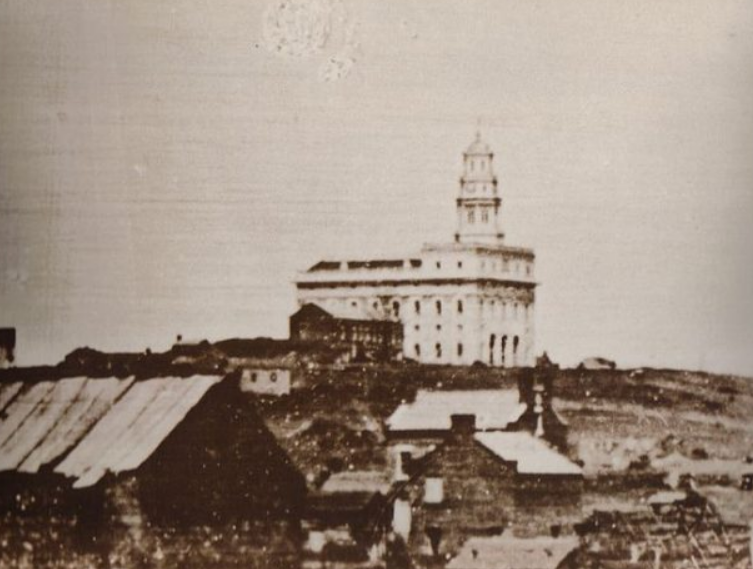
Nauvoo Temple
Their first child, Jane Ellen, was born February 5, 1846 in
Nauvoo. Persecution increased in Nauvoo, and the Saints began
to leave in large numbers between February and July of 1846. “In
February 1846, the first wagons pulled from the yards and
shops and moved toward the river. All during the spring and
summer, the chief sounds of the city were the crunching of
wagon wheels on streets leading to the ferry, the hammers
and saws now silently packed away in toolboxes in the
departing wagons. No other city in American history had ever
undergone such a transformation in so few months. No other
people, en masse, had closed the doors of their homes in
such a flourishing city and abandoned so much. By October
1846 external forces had reduced the once magnificent city
to a virtual ghost town.” (In Old Nauvoo)
"The
Battle of Nauvoo was the final chapter in the forceful
expulsion of the Mormons from Nauvoo. The so-called
Anti-Mormon Party were bent on driving the remaining
citizens out by force despite the well-known fact that most
had gone and the rest were making plans to do so.” Church
News, 9/14/96. A letter from the Church
Historical Department says, “Another document states that
John S. Haslam operated the elevator of Haines and Lambert’s
cannon during the Battle of Nauvoo, which occurred in
September 1846 and resulted in the small remnant of Saints
still in Nauvoo to be forcibly ejected from their homes." About
150 men defended Nauvoo from an angry mob of approximately
1,000 men: "Some 600 to 1,000 strong, the Regulators were
led first by Col. John Singleton and later by John Carlin of
Carthage. The core of this unlawful mob was none other than
the notorious Carthage Greys, who had played such a
prominent role in the murders of Joseph and Hyrum two years
before." (Deseret News, 14 September 1998) John and his
brothers-in-law Samuel and John Hamer were in the brave band
defending the city: "a mob of about a thousand settlers
from nearby towns and villages gathered to kick out the
Mormons of Nauvoo. 150 locals managed to rally to defend the
town. Since the town was so small, ammunition and weapons
were few and far between, although thanks to the efforts of
firearms pioneer John Browning a few of the defenders had
early repeating rifles. The defenders also modified a
steamboat shaft into a primitive cannon." (Exodus in
America; War History Online) John manned a cannon,
perhaps drawing on his experience in the British Navy. Samuel
and John Hamer were firemen for the cannon. William Ridge was
an assistant at the cannon. Charles Lambert was a powder
monkey for the cannon, bringing gunpowder to the cannon.
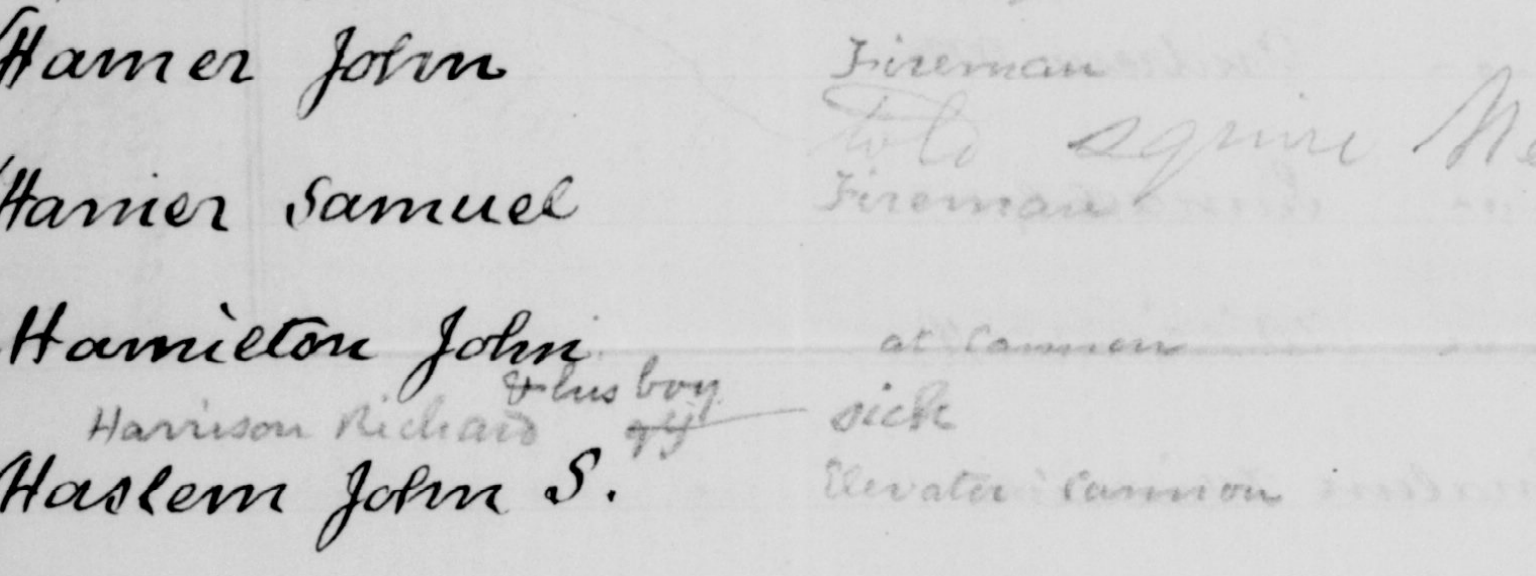
Detail from the list of men who served at the Battle of Nauvoo:
"Hamer John fireman
Hamer Samuel fireman
Haslem John S. elevator cannon"
A list of men serving in the Battle of Nauvoo, with their assignments was copied for RS Campbell's history:
Josiah Fleming, Timothy Foote (bushranger), H.H. Foster, Thomas Foster, Wm H Fulsom (sick), Andrew Fox (Spartan Band), John Fox (died), Almon L. Fullmer (Spartan Band), Hiram Gates (Capt), William Gheen (Cap of cannon no. 1), Edward Gabbut (in Lamoreaux's rifle co), Stephen Goddard (sick), William Gray, Benjamin Gray, John Gray, John Gibbs, Samuel Gurley (musician), John B Haynes (cannon, engineer), Hank Hall (new citizen*), John Hamer (fireman), Samuel Hamer (fireman), John Hamilton & his boy (at cannon), Richard Harrison (sick), John S. Haslem (elevator cannon), Charles Haslington (thumber), Wm Hathaway (cap cannon), James Hawkins, Thomas Heaps (powder monkey), Samuel Heath, Andrew Hendrie (orderly sergt), Wilkerson Hewell (Spartan Band), Joseph S. Heywood (carried ammunition), Isaac Higbee (in the temple, prayer circle), Wm A. Hickman, Peter Hiflein & son (in the battle), John Holden (rifle) James Houston (city guard), James Houghton, Simpson D. Huffaker, James W. Huntsman, Wm Jewell (mobbed & dogged 25 Sep), Charles M. Johnson (Col. sick on the 12th new citizen), William Jones, William Jones, junr, Michael Katz, Hiram Kimball (wounded with a splinter), Pineas Kimball (carried ammunition), Charles Lambert (powder monkey }Hamer Haslem), Joseph Lathrop (new citizen*), James Lawson, Andrew S. Lamoreaux (Cap. of rifle co.), Samuel Leaver, Isaac Lee, John Leonard, Truman Leonard, Jarlton Lairs, in the Temple, praying), Robert Linford (sick), Martin Littlewood, Jason R Luce, Stephen Luce, Caleb W. Lyons (sick), Wandel Mace (fiscing powder plots), Elisha Mallory, Lemuel Mallory, Cyperian Marsh (in the Temple, prayer circle), Thomas McClelland, John McEwan (clarking & in the Temple), Alexander McRae (2nd Cap of Spartan Band), William McBride, Edward Miller (Spartan Band), William Millgate, Alexander Mills (thumber), Jesse Mcleer (thumber), Alexander Mclerr, James Montague, Samuel Morton (teamster), Thomas Moss (ball handler), LaHarp Murphy (wounded bad in the leg), C.C. Nash, Alexander Neibaur, Jesse Nicholls (Spartan Band), Leir Nickerson (engineering & rifleman), Stephen Nixon (ensign), David Norris (killed by cannon ball), Nicholas Norris (Anderson Co), J. Outhouse, Seth Palmer, Henry Parker, Samuel Parker, Napoleon Parry, George Patrick, William C. Patten, Mark Peck, Morgan Phelps, Freeman Phippen, William Pickett (a kill devil*), William Player (Lamoreaux Co), Charles Player, Anson Pratt (ball handler), William D. Pratt, Daniel Prentiss, Luke Prentiss, George W. Price (Lamoreaux Co), James Proctor (Spartan Band), John Proctor, Peter Ranch, Leonard L. Randall, Enoch Reese (rifle in Lamoreaux's Co), Daniel M. Rencher (Cap. of South Co. of riflemen), Charles Rhodeback, John Riley (a Waterloo veteran i Lamoreaux's rifle Co), William Ridge (assistant at Haynes cannon }Haslem Hamer, John Robinson, Lewis Robinson, Charles Robinson (rifleman), Timothy Robinson, Merrit Rockwell (Spartan Band), Thmas Rogers, Henry Royle, John Rowsberry, Edwin Rushton, Frederick Rushton (sick), John Rushton (in Lamoreaux's, George Scholes (in Lamoreaux's rifle Co.), John Shaw (engineer), James Sloan (rifleman), Alfred Smith, Andrew M. Smith, Samuel G. Smith, William H. Smith, William Snalein (died in summer 46), Warren S. Snow (aid de camp), Thomas Spiers, Joseph Stallings, James Standing (fireman), William Standing, William Stark, John Styles (taken sick, gave his gun to another), George Styles, William Summerville (Cap. of a cannon), William Swett (city guard), Joel Terry, John Topham junr (rifleman), John Topham, Thomas Travis (cook in the chantry near Temple died Sept 29), William Turpin, George Wardel, John Wardrob (Lamoreaux Co), James Wareham (fireman), Charles Warner, John O. Waterman (commissary), Chancey G. Webb, Edwin Webb (fighting from the top a kill devil*), Daniel H. Wells (aid de camp, active), Pharez Wells, Benjamin Whitehead (wounded in the knee on 12th), James Whitehead (clerk - a cripple), James Whiteheads son Edward (abt 16), Harris Wickel (musician), Lmon Wickel (musician), Ezra G. Williams, John Word (mayor of Quincy on the Temple), John Worsley (sick), James Worthington (Cap of cannon) *New citizens and kill devils were names for new residents of Nauvoo who were not church members, but were fighting to protect their new property.
(Copied for RS Campbell's history, attached to John S. Haslam on www.familysearch.org)
The
Battle of Nauvoo is described in Church History in the
Fullness of Times: “By mid-August less than fifteen
hundred Saints remained in Nauvoo, some of them new converts
from the East who had arrived too late to join the earlier
companies. Most of them had exhausted their savings just to
reach Nauvoo and now looked to Church leaders as their only
hope to proceed West. By the second week in September the
anti-Mormons were determined to drive the Saints out of
Nauvoo. Approximately eight hundred men equipped with six
cannons prepared to lay siege to the city. The Saints and
some new citizens, numbering only about 150 fighting men,
prepared to defend the city. The Battle of Nauvoo began on
10 September, with sporadic firing. During the following two
days there were minor skirmishes. On 13 September an
anti-Mormon column advanced in an attempt to rout the
defenders. A spirited counterattack led by Daniel H. Wells
saved the day, but there were casualties on both sides. The
battle continued the next day, which was the Sabbath.”
Another history of the Battle of Nauvoo gives additional
details: “In the morning, the enemy was more determined
after receiving a few wagon loads of ammunition. They
attempted to advance on Nauvoo, but were forced back several
times by defenders firing on them from behind houses. Cannon
balls were being fired constantly. William Mace wrote, "The
little band of brethren and some of the new citizens made a
brave stand against the mob. Sometimes the cannon balls from
the mob would be picked up and loaded into our steamboat
shaft cannon and fired back at them. The defenders’ cannons
would only shoot about a quarter mile. Ammunition was scarce
with us and we were but a handful." Daniel Wells agreed,
"During the fight the boys would watch the cannon ball
strike and run and get it and bring it to us, and we would
send it back". "The mayor of Quincy watched the battle from
the top of the temple and afterwards declared that the
defenders were the bravest little band of men that ever
lived." http://www.goodnet.com/indirect/www/crockett.
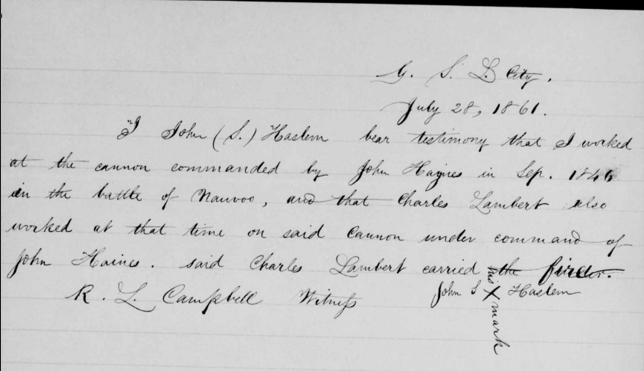
John S Haslam testimony on the Battle of Nauvoo:
"G.S.L. City July 21 1861 I John (S.) Haslem bear testimony that I worked at the cannon commanded by John Haynes in Sep. 1846 in the battle of Nauvoo,
and that Charles Lambert also worked at that time on said cannon under command of John Haines, said Charles Lambert carred the fire. R.L. Campbell witness John S Haslem his mark"
“On 16 September, the “Quincy
Committee”, which had helped keep the peace in previous
months, interceded once again. The Saints were forced to
surrender unconditionally in order to save their lives and
gain a chance of escaping across the river. Only five men
and their families were allowed to stay in Nauvoo to dispose
of property. Those who could quickly crossed the river
without provisions or additional clothing. Finally, the mob
entered the city, looted homes, and desecrated the temple.
Some Saints who were not able to escape fast enough were
beaten or thrown into the river by the mob.” Church
History in the Fullness of Times. One witness
recorded, “Scenes of destitution, misery and woe met the
eye. Families were hurrying away from their homes, without a
shelter, without means of conveyance, without tents, money,
or a day’s provision, with as much of their household stuff
as they could carry in their hands. Sick men and women were
carried upon their beds, weary mothers with helpless babes
dying in their arms hurried away—all fleeing, they scarcely
knew or cared whither, so it was from their enemies, whom
they feared more than the waves of the Mississippi, or the
heat and hunger and lingering life and dreaded death of the
prairies on which they were about to be cast. The ferry
boats were crowded, and the river bank was lined with
anxious fugitives, sadly awaiting their turn to pass over
and take up their solitary march to the wilderness.”Church News,
9/14/96. Many
of
the sickest and the weakest camped in the “misery camps” along
the river. Few had tents or enough food. Numbers of the poor
Saints, as they could, had been moving away form the river
camps to nearby villages or farms.
On
the day that the Nauvoo War broke out, several men volunteered
to leave Winter Quarters, and “bring up the poor Saints”,
even though word of the battle had not yet reached them.
Orville Allen was put in charge of the relief effort. On
October 7, Allen reached the so-called “misery camps” at
Montrose, Iowa. He found more than 300 men, women and children
camped on the banks of the Mississippi, living on boiled and
parched corn and river water. Some had died, others were
falling victim to exposure, typhus and other illness. Allen
gathered up 157 souls in 28 wagons. Thomas Bullock records a
miraculous happening, “This morning we had a direct
manifestation of the mercy and goodness of God. A large, or
rather several large flock of quails, flew into camp...The
boys and the brethren ran about after them and caught them
alive with their hands...Every man, woman and child had
quails to eat for their dinner.” The rescue company
brought all that remained out of the poor camps of Nauvoo. Church
News, 9/14/96. When Brigham Young heard of
the Battle of Nauvoo, he reminded the Saints of the covenant
that they had made in the Nauvoo Temple. This covenant was
that all of the Saints would not “cease their exertions
until every saint who wished to go was removed”. The
Saints promised to assist the poor and sick and not to leave
any behind. To motivate the rescuers, President Young told
them, “Let the fire of the covenant which you made in the
House of the Lord, burn in your hearts, like flame
unquenchable.” (Ensign, October 1997)
Winter Quarters
It
is not known exactly when the Haslam and Hamer families
arrived in Winter
Quarters. Family histories say that they arrived "at
Winter Quarters in the fall of 1846". They may have
worked their way across Iowa, or been gathered up by the
rescue wagons. The family group at this time consisted of:
John Haslam, age 23
Jane
Hamer Haslam, age 20
And
their baby, Jane Ellen Haslam, age 8 months
Jane
Thornley Hamer, age 44, and her children:
John
Hamer, age 22
Nancy
Hamer,
age 18
Ellen
Hamer,
age 16
Samuel
Hamer,
age 13
Jane
Hamer, age 11
James
Hamer,
age 9
Ann
Hamer, age 7
Winter Quarters was founded 23 September 1846. "In 1846 the
land west of the Missouri River was Indian territory, and
through agreements with the Oto and Omaha Indian tribes and
the U.S. government, the Saints were allowed to stay at this
location for almost two years." (The Mormon
Pioneer Trail) Winter
Quarters is described in this way: "Winter Quarters is
not just a place. Though historians and anthropologists may
locate in the landscape remnants of the events which happened
there, Winter Quarters is a time, a transition, a trial. It is
a cauldron, a crucible in which a people, converted to a new
and demanding faith, were cleansed by cold and hunger,
baptized in the great pool of their suffering and redeemed by
the outpouring of spiritual manifestation." (Church
News, November 30, 1996) “The headquarters of the
Church was at Winter Quarters in Indian territory, where
almost four thousand Saints resided by the end of the
year...The hasty, wintry exodus from Nauvoo earlier in the
year, the exhausting trek across Iowa, the endless spring
storms, insufficient provisions, inadequate and improvised
shelter, the forced exodus of the poor from Nauvoo, and
unhealthy riverbank environments all took their toll. Over
seven hundred people died in the camps by the end of the first
winter. But all was not sorrow, especially in Winter Quarters.
Life there could still be generally pleasant, rewarding, and
meaningful. Church meetings were held twice a week, and the
sermons from the leaders raised the morale of the entire
settlement. Many family meetings were held as well. After much
of the hard labor of establishing the community was complete,
Brigham Young encouraged the wards to celebrate with feasts
and dancing. Women often came together in neighborhood groups
to gather food, quilt, braid straw, comb each other’s hair,
knit, wash clothes, and read letters. Throughout the winter of
1846-47, additional preparations were made for continuing the
westward exodus.” (Church History in the Fullness of
Times) The location of Winter Quarters “offered
excellent river transportation, defense from marauding
Indians, fresh water access, and near proximity for grazing
the 10,000 head of cattle which accompanied the Saints. Winter
Quarters was divided into 22 wards, each comprising a city
block. “By 30 December 1846, Winter Quarters consisted of 538
log cabins, 83 sod houses, and a population of 3,483.” (Church
News, February 1, 1997) The Saints suffered much
from scurvy the first winter, due to the lack of fresh
vegetables.
John’s
services
as a blacksmith were greatly needed help make wagons for the
Saint’s westward trek. Brigham Young asked him to stay at the
Saint’s outfitting point. At Winter Quarters they built a
one-room house of logs, and lived there several years while
Samuel Hamer, Jr. and John S. Haslam helped the Saints carry
supplies and immigrants across the Missouri River. They also
did blacksmith work while living at Winter Quarters. A son,
John Joseph, was born to John and Martha in Winter Quarters on
March 2, 1848. After the birth of the new baby, John S. and
Samuel Hamer, Jr. went back to the Missouri River to work to
get money to immigrate to Utah.
In 1848 Winter Quarters was abandoned, and Kanesville, across the river, became the gathering spot for Mormon pioneers.
John is found with his family in the 1850 census in Pottawatamie County, Iowa:
John Amer, age 26, occupation: blacksmith
Elizabeth, age 18
John Hazlem, age 27
Martha, age 24
Jane, age 4
John, age 2
Jane Amer, age 49
Samuel, age 17, occupation: none
Jane, age 15
James, age 13
Ann, age 12
Source: 1850 federal census, Iowa, Pottawattamie County,
District 21, page 112, on ancestry.com.
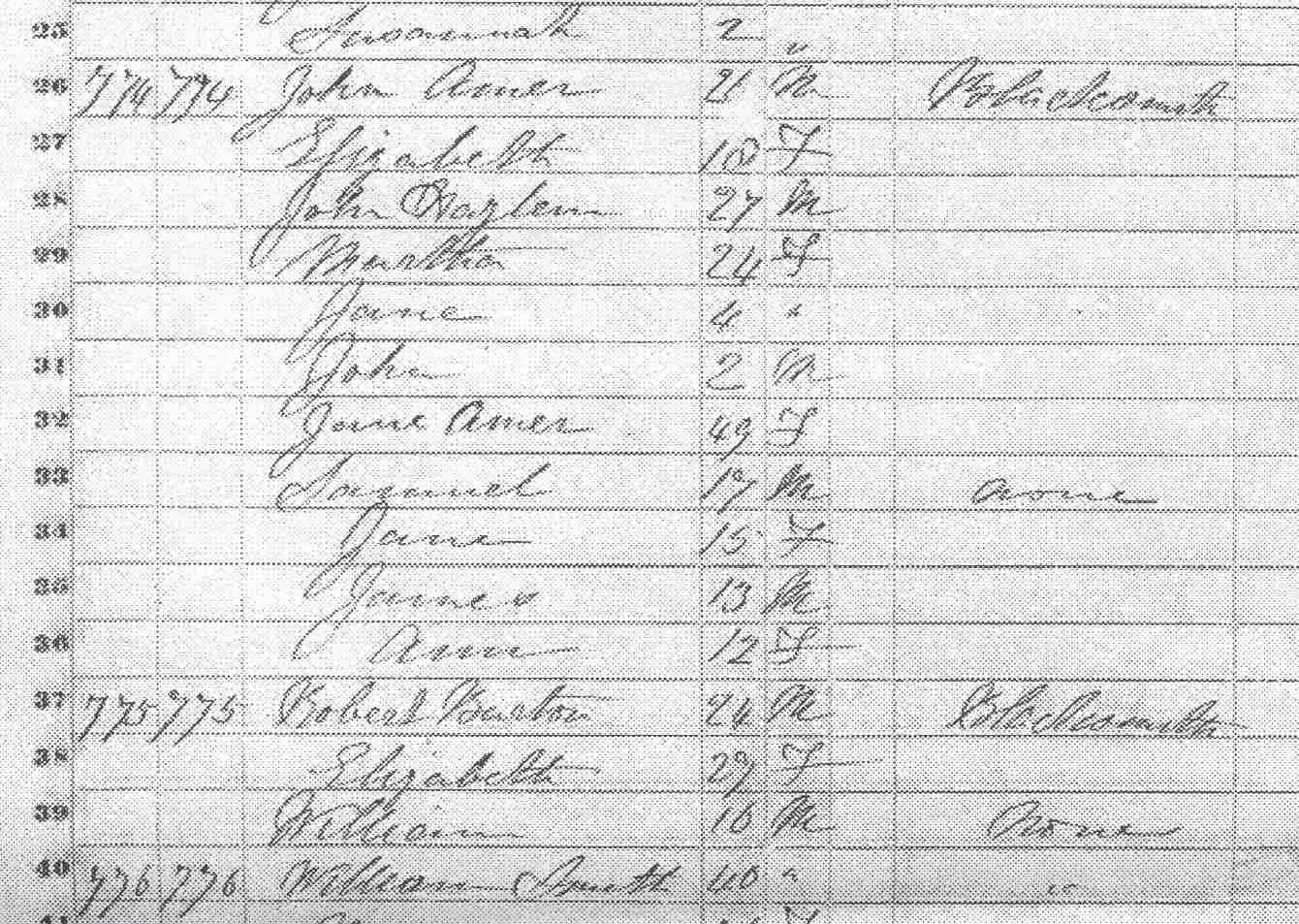
1850 census, Pottawattamie, Iowa
A second son, Samuel Hamer Haslam, was born to John and Martha
in Ferryville, Pottawattamie, Iowa, on March 2, 1851. About
twenty-five hundred Saints were camped on Pottawattamie Indian
lands on the east side of the Missouri river. Ferryville was the
site of the North Mormon Ferry.
Crossing the Plains
John did not leave for the
Salt Lake Valley until 1851. Family records say the family
traveled with the Orson Pratt company. They are shown on LDS
records with the James W. Cummings Hundred, which was part of
the O. Pratt First Hundred. This company left Kanesville, Iowa
on July 1, 1851. There were about 150 individuals and 100
wagons when they left. The roll of the First Hundred of O.
Pratts Company show:
Second Ten
George Spratley[,] Capt.: 4 Souls, 1 Waggon, 4 Oxen, 2
Cows
Alfred Cordon: 6 Souls, 1 Waggon, 6 Oxen, 2 Cows
Jno. [John] Wood: 5 Souls, 1 Waggon, 4 Oxen, 4 Cows
Jno. [John] Hayes: 6 Souls, 1 Wagon, 4 Oxen, 2 Cows
George Baddaley: 4 Souls, 1 Waggon, 4 Oxen, 2 Cows
Richard Steel: 5 Souls, 1 Waggon, 5 Oxen, 3 Cows, 1
Horse
Edwin Oakley [Okey]: 5 Souls, 1 Waggon, 4 Oxen, 2 Cows,
Ephraim Luce: 1 Soul, 1 Waggon, 2 Horses
Jno. [John] Haslam: 5 Souls, 1 Waggon, 4
Oxen, 2 Cows
Jno. [John] Hamer: 2 Souls, 1 Waggon, 4 Oxen, 1
Cow
Wm Player: 2 Souls, 1 Waggon, 4 Oxen, 2 Cows, 1 Horse
John Henry Haslem tells, “In crossing the plains
they all started with Brigham Young and the first company in
1847, but when they got to where they built the wagons and
handcarts, Brigham asked John S. Haslem and Mr. Hamer to
stay there and make wagons and handcarts for the immigrants
for a year or more. He told them to let the rest of their
families go on. Had they taken Brigham Young's advice they
wouldn't have had trouble, as they had plenty of food there
to get them through in good shape. But they didn't like to
be separated, so decided to all stay (twenty or more men),
and they would hurry and get all the carts and wagons made,
and then go the next summer, as they thought they would have
food to last that long. But next spring they had no surplus
wagons as the immigrants took them as fast as they could
make them. By the way, if they did get any pay for their
work, they didn't get enough to replace their food they ate
while they were making these wagons. If the immigrants
didn't have anything to trade for wagons, Brigham said to
let them have them anyway, as their labor was classed as a
mission for the Church. So they didn't want to be pikers
after Brigham had asked them to stay, so the years went by
until they were getting so short of food they decided if
they were going to get to Utah as all, they had to start.
As John S. Haslem was making wagons
for the immigrants, there came a party of trappers that could
go no farther with their full wagon as they went off the main
roads in their trapping business. So John S. Haslem made a
tongue to go in the rear axle of their wagon and a box to put
their stuff in so they could ride on top, or in other words, a
two-wheeled cart that was high so it would go over the stumps
and high roads. These trappers were so pleased they gave him
twenty dollars, and about the only money he had seen for a
long time, and twenty dollars was a lot in those times. They
were starting on their trip at 3 p.m., so John S. told them
they had better wait until next morning and sleep in the shop
where it was dry, as it was storming. So when the trappers
went for their horses at daybreak next morning one had died,
and they didn't have enough money, if it was available, so
John S. felt so bad for them he asked them how long they
expected to be gone. They thought one year at the most, and
maybe six months if they got a load of furs that soon. So John
S. told them to take one of his horses, as he thought he
wouldn't need his team which, by the way, was a good team. So
they did and left John S. with one horse. But when he decided
to start to Utah, he had only one horse and no money to buy a
good one, and horses were very scarce. People used mostly oxen
these days at this place, so John S. bought a little Indian
pony for three dollars and put it with his big horse, and made
the big horse pull most of the wagon, which was OK until they
hit muddy roads. Then they had to discard most of the load, as
the horses could not pull it.
If my memory serves me right,
Granddad’s (John S.) wagon was the only one in the company.
All the rest were handcarts. So the wagon was mostly full of
ill people and small children too small to walk. So they
plodded on as best they could, until their horses gave out,
and they could only make a few miles a day. So the rest of the
company could go faster, they went on and said they would send
someone back to rescue them. They expected to find help at Ft.
Bridger, Wyoming, but no one was there to send back. Because
of such slow travel they were getting short of food, and lived
on nothing but the wild game they would shoot. But about now
they ran out of ammunition so they couldn't get what few
rabbits and deer were there. So for many days all they had to
eat was the old bones the coyotes had left. They would mash
them and crush them with the back of an ax, and boil the
marrow out of the center in a big thirty-gallon iron pot. As
long as they could see one bead of grease on the soup they ate
it, and it saved them from starving for many days (and that
was a testimony to them that the Lord put something in the
soup to keep them well). But with that diet they soon got so
weak they could go no farther.
They came to an old trapper's cabin
built of just logs with nothing in the cracks. But it had a
fireplace in the end, so they filled the cracks as best they
could with cedar bark, and moved their bedding and grub boxes
in— which was all they had room for, by the time twenty or
more people got in. They all had to sleep in one bed on the
floor, while one sat up all night to keep a big fire to help
keep warm, as it was one of those Wyoming blizzards that are
so common at that time of year. By now they had lost their
hope of being rescued, as they had prayed for so many days,
and the hunger pains were so bad. They decided this was the
end. But they would be in the cabin with a little protection
from the weather and their corpses would be found. But this
night they prayed extra long, then all went to bed, except the
oldest woman was to sit up and keep the fire going. As she was
watching the fire she heard something behind her, and there
was a big white rabbit she said was nearly as big as a sheep,
standing on its hind legs, on the foot of the bed where the
boys were sleeping. He stood there while she woke the boy to
grab him, and she was so sure he would get away. As she woke
the boy, he grabbed it, and it didn't get away, so they
cleaned it and put it in their thirty gallon pot that was
already hot on the fire. They started to eat the soup almost
before it boiled. They said that was the best meal either of
them had ever tasted, even though it was only rabbit. He
lasted them two days. The storm quit and here came the
trappers with John S.'s horse and quite a little surplus corn
they had traded for from the Indians. That lasted until one of
Brigham Young's rescue wagons came with food to last the
remainder of their journey.” (John Henry
Haslem)
John and Martha's six-year-old daughter, Jane Ellen
remembered walking most of the way across the plains with her
mother and four-year-old brother, hand in hand, and caring for
another baby brother. She related that "only through the
help of the Lord were their lives spared." (Gerald
B. Haycock, on file at Nauvoo Land and Records Office)
Salt Lake City
They
arrived in the Salt Lake Valley in October of 1851. John went
to work in the Church blacksmith shop. Each family of settlers
received an allotment of ten acres of land. The Haslams owned
a block of land between 1st and 2nd North, and between 5th and
6th West. The Haslams made their home in the 16th Ward. Ward
records show that John and Martha and their children lived
next door to Martha’s mother, and brother and his family.
Martha’s brother, John, also worked as a blacksmith. John took
the letter “S” to differentiate himself from a neighbor, John
R. Haslam, who was also from Bolton. This John R Haslam was
the John Haslam mentioned in Brigham Young’s daughter’s book,
as her father’s storekeeper. The store records are still in
the possession of his descendants.

Wood stamped with a branding iron made and used by John S
Haslam
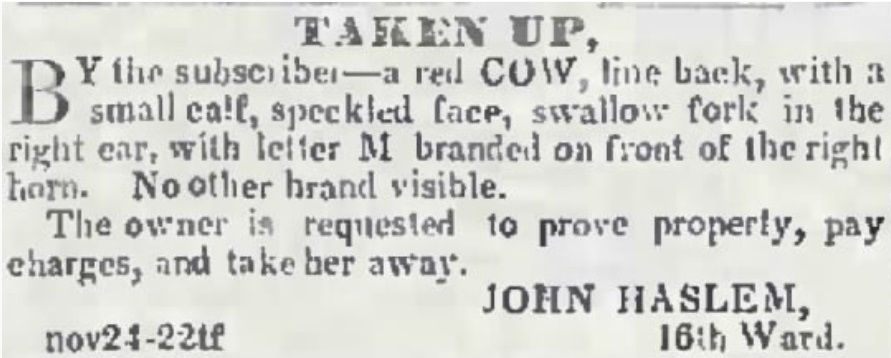
Advertisement for a found cow in the Salt Lake Daily Telegraph, 2 December 1853
In Orson F. Whitney’s History of Utah, a newcomer to Salt Lake City in 1854 tells this interesting story, “Having no opportunity to rent a shop on Main street—there were no shops there for barbers—and being bound to do something in my line, I took my satchel, which contained a set of barber’s tools, and started out to seek employment. The first house I came to I inquired of a lady who stood at an open door if she would like to have her children’s hair cut. She answered no. I then proceeded to the next building, which was the blacksmith shop of Haslam & Hamer. I made known my business and soon I had them seated on the anvil and left them all with clean chins.” (Orson F. Whitney, History of Utah, Vol. 4, p. 464)
The Haslam family appear in the 16th
Ward records:
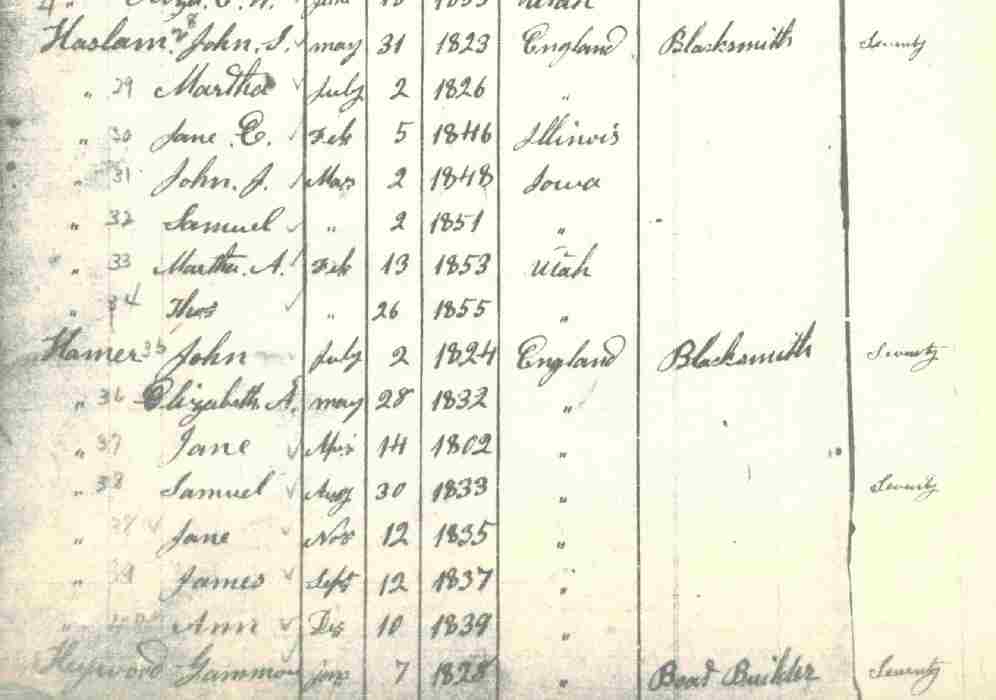
16th Ward Records, Salt Lake City, FHL# 26679
The same ward records show that John served as a Block Teacher:

16th Ward Records
This
was a productive time for John and Martha Haslam. More
children came into the Haslam family, to join the Haslam’s
daughter and two sons. Martha Ann was born February 13, 1852.
Then another son, Thomas was born February 1855. A third
daughter, Elizabeth, was born next, on September 1857. A
fourth son, Brigham was born March 21, 1860. He was the first
of the Haslam children to die as a child. One year later, on
June 20, 1861, another son, William was born. A daughter,
Mary, was born two years later, on April 25, 1863. Next a son,
Joshua, was born on February 2, 1865. Finally, a daughter,
Ruth, was born on June 6, 1867. Altogether, John and Martha
had eleven children, six sons and five daughters. Martha was
41 at the birth of her last daughter. It was a difficult
birth, and Martha lingered for ten days before dying of
complications due to childbirth. The baby, Ruth, only lived
three months before she also died.
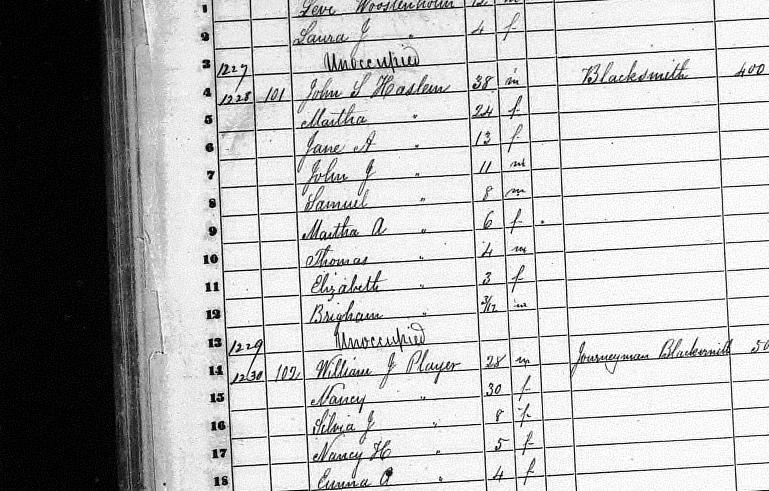
1860 census, Salt Lake City, Utah

Advertisement for John S Haslam in the Salt Lake Daily
Telegraph, 8 October 1864
The Muddy Mission
John
sorrowed for the loss of his wife of 22 years, and struggled
with the job of raising a large family of young children. On
the 8th of October, 1867, at the first conference
that convened in the Tabernacle, many missionaries were called
to settle and strengthen the settlements of southern Utah.
John was called by President Brigham Young to take his family
and go settle Panaca,
Lincoln County, Utah, on what was called the “Muddy Mission”.
President Young advised him to marry again. He suggested Mary
Ann Kay Openshaw. She was an abused wife, with a young
daughter, who had been given a temple divorce. John agreed,
and they were married on November 9, 1867. Two weeks later
they left for Panaca. John sold most of his land in Salt Lake,
except for 200 feet or so each way from the northeast corner
of the block. He bought a team of oxen for the 300 mile trip.
Their time on this mission was challenging: “They
travelled by ox-team and wagon and arrived a few days before
Christmas in December 1867. His friend and brother-in-law,
Samuel Hamer Jr. and his family were also called to go on
this mission. On arrival they built a blacksmith shop and
worked together for 3 1/2 years. These were years of
unbelievable hardship. They first lived in a dugout, where
their children Maggie, and James Kay Haslam were born. Later
they had a tent to live in. Joshua's father had bought him a
new pocket knife before leaving Salt Lake City. Joshua,
almost three years old would not eat his dinner one day. He
was sent outside while the family ate dinner. This made him
angry, and he cut the tent ropes with his pocket knife. He
said that he got a good spanking which he never forgot.
Following a survey by the State of Nevada, Panaca was
declared legally to be a part of Nevada, therefore these
settlers were asked to pay back taxes to the State of
Nevada, and could not pay more to Utah. Brigham Young gave
permission for these settlers to return to their homes in
Utah. However, six families chose to remain and fight the
issue in court. The Judge gave the verdict in their favor,
saying they had paid their taxes conscientiously to the
State of Utah, and therefore they would not be required to
pay their taxes to Nevada. However, from then on the
settlers who remained were to pay their taxes to Nevada.
This situation, combined with poor crops, extreme hardships,
and coping with Indians who helped themselves to the
settlers' belonging, were discouraging enough to make these
pioneers forsake Panaca, and return to their former homes or
go wherever they chose.” (Gladys Haslam Drennan)
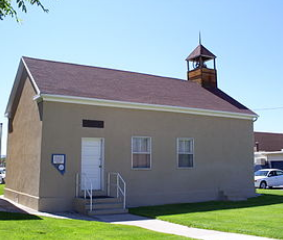
Panaca Ward Chapel, built 1867-8
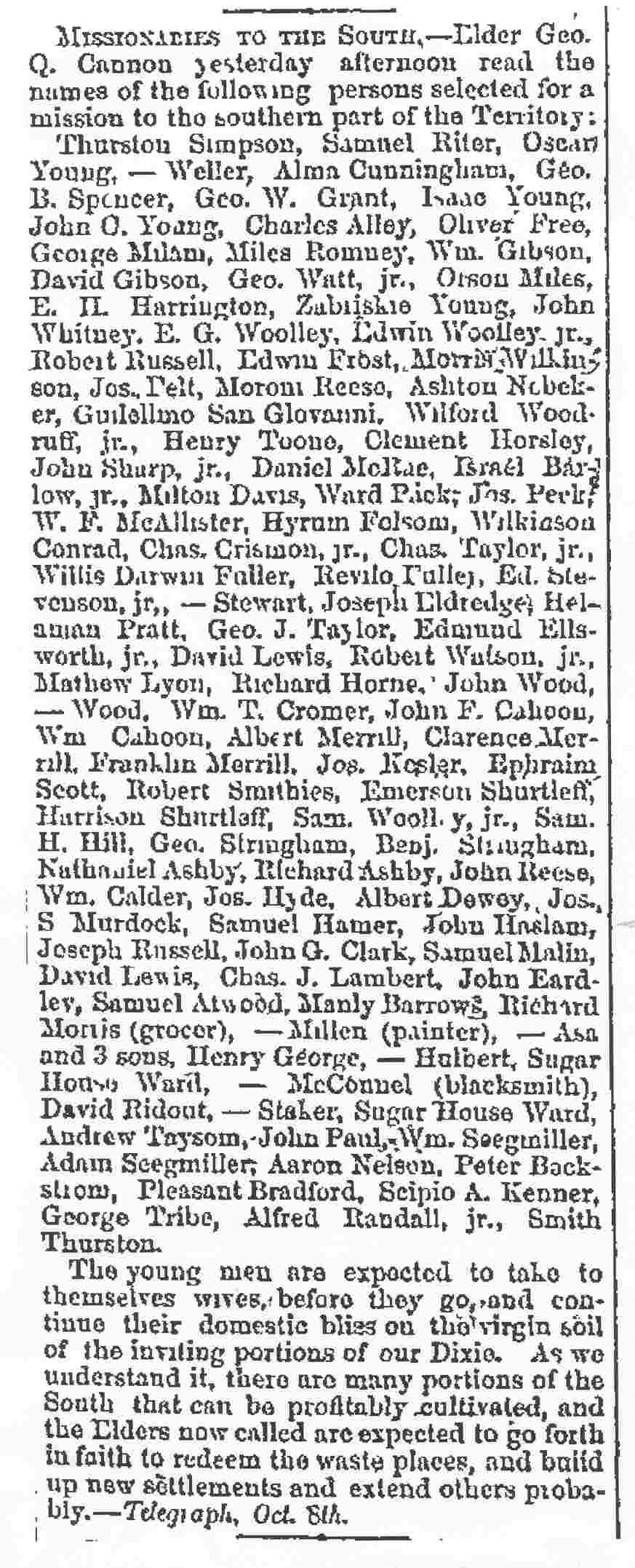
Deseret News, October 8, 1867
Back in Salt Lake City
John
and his family returned to Salt Lake City in June of 1871.
They built a two-room house with a summer kitchen on the
property he had not sold. Later other rooms were added to the
part brick and part frame house. Mary Ann was a loving mother
to all the children. Three more were born to John and Mary
Ann: Zina in 1873, Enos Moroni in 1875, and Annie Isabel in
1878. “Maggie died of Scarlet Fever at the age of six
years, and Enos and Zina died within a week of each other
with Diphtheria. In those days they had high mortality
rates. John and Mary lost seven children in twelve years in
addition to John and Martha's baby Ruth, and Martha herself
in 1867. One child died each year for four years, and two in
one week from contagious diseases. This indicated the trying
times that they lived in. John S Haslam had sixteen children
by his two wives, and adopted Martha Jane Openshaw whom he
raised as his own.” (Gladys Haslam Drennan)
John S Haslam's home (picture courtesy of Marilyn Groneman)
John
continued a life of righteous service. He was an usher in the
Salt Lake Tabernacle for many years. His kindness is shown
when, “There is a story that Heber C. Kimball asked him to
repair a wheel on his wagon so that his family could go to a
celebration. Noticing that the Kimball children needed
shoes, he refused to take any money, but instead said to use
the money to buy shoes for the children.”
John is found in the 1880 federal census in Salt Lake City:
John S. Haslem, age 56, born in England, occupation:
Blacksmith
Mary Ann Haslem, wife, age 44, born in England, keeping house
Martha Jane Haslem, daughter, age 16, born in Utah
James Kay Haslem, son, age 9, born in Utah, occupation:
School boy
Annie Haslem, daughter, age 2, born in Utah
FHL# 1255337
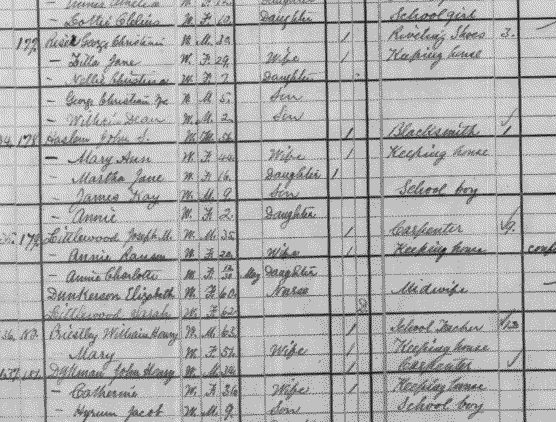
1880 census, Salt Lake City, Utah
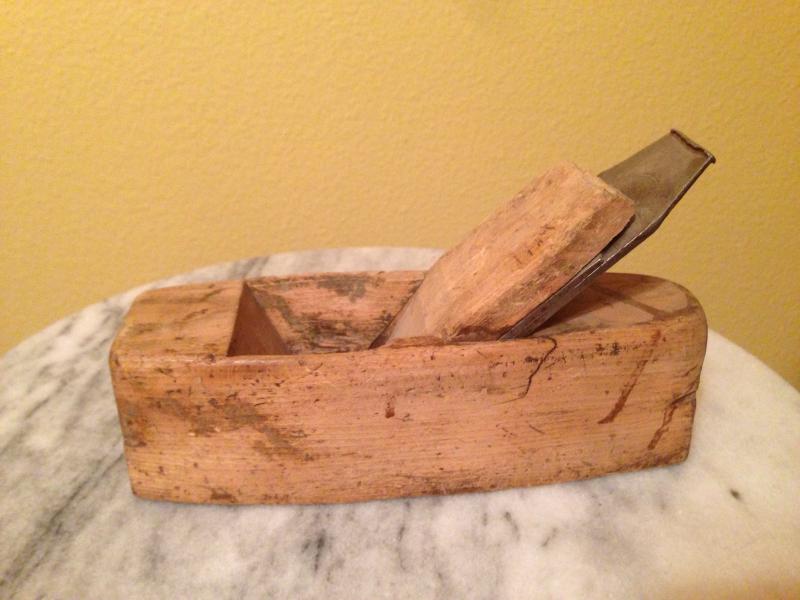
Wood plane belonging to John S Haslam
from FamilySearch, courtesy of Spencer Robert Drennan
One of John S. Haslam's descendants, Jim Haslam, has in his
possession a boot-tree made by John: "This is really a great
item. It is made of iron and has such great details. I'm told
that it was used to remove boots by standing on the main
section with one foot, placing the heel of the boot of the
other foot into the antennae section of the boot-tree, and
then lifting/pulling the boot off the foot by pulling up
with your leg. I now just use it for decoration and have never
placed a boot in it to see if this works.I remember playing
with it as a kid at my Grandfather's house (Ralph Wesley
Haslam). It was made by his grandfather (John S Haslam). It
was passed down from John S, to James Kay, to Ralph Wesley, to
Ralph Douglas, and then to me (James Douglas Haslam). I
treasure this wonderful family heirloom." (Thanks to
Jim Haslam for sharing these pictures.)
John
went to work for James Lawson at his blacksmith shop on 2nd
West and 1st North. He also worked at the church blacksmith
shop, and for the Utah Central Railroad, where he lost his
sight in one eye, “It was here that he got a piece of
steel in his eye, requiring him to have an operation on it.
Several people at work helped to raise the money for the
surgery, but it was not a success, and he went blind in that
eye.” (Gladys Haslam Drennan) Shortly after that he
found that he had a cataract in the other eye, and needed
another operation. By 1883 he was totally blind.
His Death
John S Haslem
(picture courtesy of Marilyn Groneman)
John
became ill with bronchitis in the end of 1883. He was sixty
years old. He died on November 27, 1883. His obituary stated,
“The death of Brother John S. Haslem is among the sad
events to be chronicled. He expired yesterday at his home in
the Sixteenth Ward, his disease being consumption. The
funeral will be held in that Ward meeting house on Thursday,
November 19th, at 10 o’clock a.m., to which the friends of
the family are invited. The deceased was aged 60 years, 5
months and 26 days. He was born in Bolton, Lancashire,
England, was baptised in 1842, and emigrated in the autumn
of 1842 in the same ship with Elder Orson Hyde on his return
from Jerusalem. He tarried in St. Louis until the summer of
1844, and then went to Nauvoo, and remained there until the
Saints were expelled in the fall of 1846. He was at Winter
Quarters the same fall, and emigrated to Utah in 1851. He
was ordained a Seventy in Nauvoo, and belonged to the 29th
Quorum. He lived a faithful Saint and died in the hope of a
glorious resurrection.”
In a
column called “Our Gallery of Pioneers” the story of
John S Haslam’s life is told: “This veteran, one of the
pioneer blacksmiths of Utah, was born at Bolton, Lancashire,
England, in the year 1823. In 1842 he joined the Latter-day
Saints and immigrated to the United States two years later. He
tarried at St. Louis two years and then proceeded to Nauvoo,
Ill. With the expelled community who had built and who
occupied that fair city, he started westward in 1846, working
at his trade while on the way, his services being in such
demand at the point of outfitting for the journey across the
plains that his own arrival in Salt Lake valley did not occur
until 1851. Thereafter he was employed in the Church
blacksmith shop and in other places where his skill was
needed. He made his home in the Sixteenth Ward, Salt Lake
City, where he resided until his death in November 1883. He
was a clever and conscientious workman, and a highly respected
citizen.” Perhaps the best tribute to John S Haslam was a note
scrawled over this column, written by a descendant, saying,
“This is a nice thing to keep. There could have been lots
more. He sure was a good man.”
Additional
biographies of John S Haslam:
John S Haslam by Carl E. and Velda H. Johnson
Biography of John "S" Haslam by Martha Gladys Haslam Drennan
History of John S. Haslam by Katie Haslam Horrocks
John S. Haslem by John Henry Haslem
Letters to John Haslam from his family in England
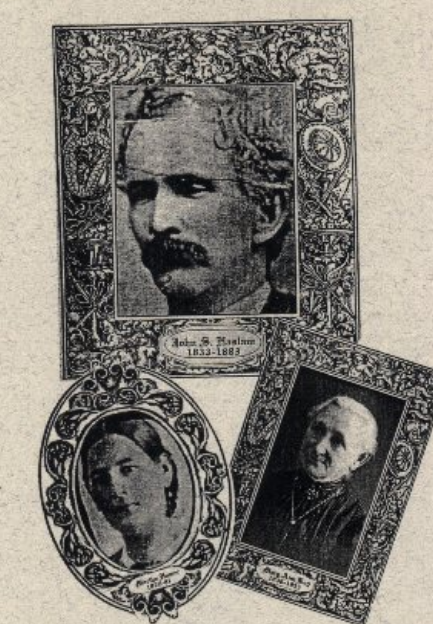
FAMILY GROUP RECORD OF
JOHN
S
HASLAM
AND MARTHA HAMER
John
S Haslam was born 31 May 1823 in Bolton,
Lancashire, England to Elizabeth (Betsy) Haslam. He married
Martha Hamer 4 March 1845 in Nauvoo,
Hancock, Illinois. Martha was born 1 July 1826 in Bolton to
Samuel Hamer and Jane Thornley. She died 16 June 1867 in Salt
Lake City. John married again, to Mary Ann Kay 12 September
1836. Mary Ann was the daughter of Thomas Kay and Mary Ann
Collins, born 20 April 1836 in Haywood, Lancashire, England.
John died 27 November 1883 in Salt Lake City, Utah; and was
buried 29 November 1883 in Salt Lake City.
John and Martha had the following children:
1. Jane Ellen, born 5 February
1846 in Nauvoo; married Joseph Heaps Spencer in 1869; died 25
February 1916.
2. John Joseph, born 2 March 1848
in Winter
Quarters, Nebraska; married Sarah Ellen Entwistle; died 7
October 1908.
3. Samuel Hamer, born 2 March 1851
in Ferryville,
Pottawattome, Iowa; married Margaret Elizabeth Huffman 20 July
1887; died 22 July 1924.
4. Martha Ann, born 13 February
1852 in Salt Lake City, Utah; married Charles Holmes in 1871;
died 1 February 1904.
5. Thomas, born 26 February
1855 in Salt Lake City; died 7 May 1872 in Salt Lake City.
6. Elizabeth, born 19 September
1857 in Salt Lake City; married George Bennett; died 27 June
1937.
7. Brigham, born 21 March 1860
in Salt Lake City; died as a child.
8. William, born 20 June 1861
in Salt Lake City; died 27 November 1875 in Salt Lake City.
9. Mary, born 25 April 1863
in Salt Lake City; died 3 March 1873 in Salt Lake City.
10. Joshua, born 2 February
1865 in Salt Lake City; married Alice Southam 27 July 1887; died
4 August 1934.
11. Ruth, born 6 June 1867
in Salt Lake City; died 6 September 1867.
John
S Haslam and Mary Ann Kay had the following children:
1. Maggie Kay, born 8 August 1868
in Panaca,
Lincoln, Nevada; died 5 June 1874 in Salt Lake City.
2. James Kay, born 16 February
1871 in Panaca; married Martha Willden 9 September 1896; died 28
September 1950.
3. Zina, born 13 July 1873
in Salt Lake City; died 8 December 1879 in Salt Lake City.
4. Enos Moroni, born 29 August
1875 in Salt Lake City; died 11 December 1879 Salt Lake City.
5. Annie Isabel, born 20 February
1878 in Salt Lake City; married Alfred J. Luce 27 December 1899;
died 14 June 1960.
Mary
Ann also had child by a previous marriage to George Openshaw:
Martha Jane Openshaw, born 8 April 1864 in Salt Lake City.
Mary Ann died 12 September 1925 in Salt Lake City.
SOURCES: John S Haslam by Carl E. and Velda H. Johnson;
Biography of John "S" Haslam by Martha Gladys Haslam Drennan;
History of John S. Haslam by Katie Haslam Horrocks; John S.
Haslam by Myra King; John S. Haslem by John Henry Haslem;
Letters to John Haslam from his family in England,
https://boydhouse.com/alice/Haslam/johnhaslamletters.html; Biography
by Johathan Edward Openshaw, one of the sons of Job
Openshaw; Nauvoo Seventies Quorum record for John
Haslam; Baptism record for Thomas Haslam in Bolton le Moors
(Bishops Transcripts, Bolton le Moors) ; Biography by Johathan
Edward Openshaw, one of the sons of Job Openshaw; Nauvoo,
Illinois Tax Index, 1842, on ancestry.com; Marriage record for
John Haslam and Martha Hamer in St. Louis, Missouri Marriages,
1750-1920; Records of the Land and Records Office in Nauvoo;
70s Rec, 29 Qrm, Bk B Sel, 1845, LDS Arc, pg. 113, Land and
Records Office, Nauvoo; Nauvoo Temple Records; Letter from the
Church Historical Department re: Battle of Nauvoo; list of men
who served at the Battle of Nauvoo; Exodus in America; War
History Online; RS Campbell's history, attached to John S.
Haslam on www.familysearch.org; John S Haslam testimony on the
Battle of Nauvoo, Collected Information concerning the Battle
of Nauvoo, 1846-1861,
https://catalog.churchofjesuschrist.org/assets/1c1d1aff-985e-4333-afde-66208bcd189c/0/0;
1850 U.S. federal census, Iowa, Pottawattamie County, District
21, page 112, on ancestry.com; The Roll of the First Hundred
of O. Pratts Company; Salt Lake Daily Telegraph, 2 December
1853; Utah Mormon Pioneer Travel Database, 1847-1868; Orson F.
Whitney, History of Utah, Vol. 4, p. 464; 16th Ward Records,
Salt Lake City, FHL# 26679; 1860 U.S. census, Salt Lake City,
Utah; Salt Lake Daily Telegraph, 8 October 1864; Deseret News,
October 8, 1867; 1880 U.S. federal census, Salt Lake City,
Utah, FHL# 1255337; Obituary, Deseret News 5 December 1883;
Utah Deaths and Burials.